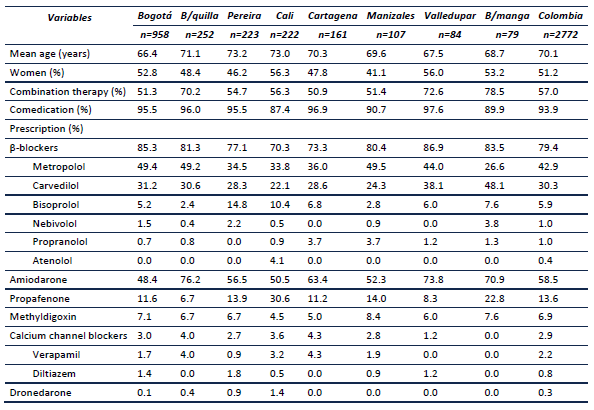Introduction
Cardiac arrhythmias are defined as any irregularity in the formation or conduction of the cardiac electrical stimulus. Cardiac arrhythmias manifest in people of any age with or without structural or functional heart disease1. Cardiac arrhythmias occur in 1 to 5% of the adult population. Atrial fibrillation is the most frequent, with a prevalence of 1.5 to 2% in the general population, reaching 6% in people over 65 years and 10% in those older than 80 years2.
It is estimated that one in four people over 40 years will suffer this disease during their life. It is projected that 5.6 million people will be affected by the year 2050 in the United States3,4. Heart rhythm disorders have increased their prevalence and are a common reason for hospital admissions. Costs and total hospitalizations have increased two to threefold in the United Kingdom in recent years, where 50% of the estimated expenditures represented hospitalizations and 20% were attributed to medications5.
In Colombia, cardiovascular diseases represented the main cause of death between 2005 and 2012. In total, 147 deaths per 100,000 inhabitants were reported for this cause, leading to 30% of deaths and 16% of all years of life potentially lost6. Of the deaths in this group, ischemic diseases of the heart accounted for 49% and hypertensive diseases accounted for 10%. These data are relevant given that these diseases are related to the development of cardiac arrhythmias6-9. It is estimated that approximately 16,000 new cases of atrial fibrillation occurred in 2009 in Colombia. During the period 2000-2009, atrial fibrillation caused approximately 2000 deaths, with a loss of 137,732 years of life adjusted for disability10.
Pharmacological therapy has been a fundamental part of the treatment of arrhythmias along with the electrophysiology techniques that have been gaining ground over time. Antiarrhythmic drugs are an extensive group of molecules that are differentiated by their mechanisms of action and adverse reactions; however, these drugs share the potential to trigger new arrhythmias11. Due to the variability in their actions, efficacy and safety limitations and the multiplicity of existing arrhythmias, which range from benign to potentially fatal, each patient must be studied in detail to select the best antiarrhythmic drug according to the risk/benefit profile11.
Due to the absence of related studies in Colombia and the increase in the prevalence of cardiovascular diseases in the population, we sought to determine the prescription patterns of the drugs used for the treatment of cardiac arrhythmias in patients affiliated to the Colombia Health System during 2016. The risk of acquired long QT syndrome was also assessed, according to co-medications associated with drug-induced QT interval prolongation. This study will generate the first baseline information that will contribute to the proper management of cardiac arrhythmias, avoid complications and improve the health of the population.
Materials and methods
A cross-sectional study was performed on prescription patterns of antiarrhythmic drugs in Colombia. Information was obtained from a national database of approximately 3.5 million people affiliated with five Health Promoting Entities (insurers) functioning under the contributory regime of the Colombian social security system, which corresponds to approximately 17.5% of the population covered by this regime and 7.3% of the Colombian population.
We analyzed prescription data for patients treated with antiarrhythmic drugs between March 1 and May 31, 2016 in all Colombian cities where reliable databases were available. We included data on individuals of all ages and any gender who were dispensed antiarrhythmic medication, and whose treatment continued uninterrupted for at least three months to ensure that patients complied with the treatment in a stable manner, demonstrating tolerance and adherence to medication.
From the information on the consumption of medicines of the affiliated population systematically obtained by the dispensing company (Audifarma S.A.), a database was designed with the following variables: sociodemographic, antiarrhythmic medication. The defined daily dose (DDD) was used as the unit of measurement of the use of these drugs according to the recommendations of the World Health Organization (WHO).
A search was made in the drug dispensing database of the diagnoses related to arrhythmias according to the International Classification of Diseases, tenth revision - ICD10 (Supplementary Table 1) to identify whether β-blockers and calcium channel blockers (non-dihydropyridines) were used for the indication of heart rhythm disorder. The codes were searched for each patient up to three months in advance of the study period for a total of six months of review. Those patients with a β-blocker and calcium channel blocker dispensation who did not have an arrhythmia diagnosis during a period of six months (including the three months of the study) were excluded.
Comedication was accepted as a surrogate indicator of chronic disease based on the following circumstances: a) antidiabetics and insulins/diabetes mellitus; b) antihypertensive and diuretic/arterial hypertension; c) anticoagulants/thromboembolic disorders; d) psychotropic medication (antidepressants, antipsychotics, antiepileptics, sedatives and hypnotics)/neurological or psychiatric disorder; e) lipid-lowering/dyslipidemia; f) thyroid hormone, antithyroid drugs/thyroid disease; g) nitrovasodilators/ischemic heart disease; h) antiulcer agents/peptic ulcer disease; i) erythropoietin/end-stage renal disease; j) bronchodilators/chronic obstructive pulmonary disease and asthma; k) antiplatelet drugs/cardiovascular prevention. The pharmacological effects that antiarrhythmic drugs can have on comorbidity were analyzed.
We included agents that can lead to early afterdepolarizations in addition to the antiarrhythmics themselves (class Ia, Ib and III), phenothiazines, tricyclic antidepressants and antihistamines1. We searched for co-prescriptions of drugs that generate risk of acquired long QT syndrome that were classified as drugs with known risk, possible risk and conditional risk according to the classification of "QTDrugs List" (Crediblemeds.org)12.
The statistical package SPSS® version 24.0 (IBM, USA) for Windows was used for data analysis. The descriptive statistics used were the average, standard deviation, minimum and maximum values for continuous variables and percentages for categorical variables. Student’s t tests were performed for the comparison of quantitative variables, and X 2 was performed for categorical variable. A logistic regression model was employed with the use of antiarrhythmic drugs alone or associated (yes/no) and the need for comedication (yes/no) as the dependent variables. Covariates were those significantly associated with the dependent variables in the bivariate analyses. A p<0.05 was established as a level of statistical significance.
The protocol was endorsed by the bioethics committee of the Universidad Tecnológica de Pereira classified in the category of "risk-free research", safeguarding the identity of patients and following the recommendations of the Declaration of Helsinki.
Results
Of the 2772 patients affiliated in the Colombian social system in treatment with antiarrhythmic drugs for a period of not less than three months, the average age was 70.1 ± 13.1 years (range: 18.8-98.6 years), and the distribution by sex revealed that 51.2% were women. There were 75% older than 64 years old (figure 1).
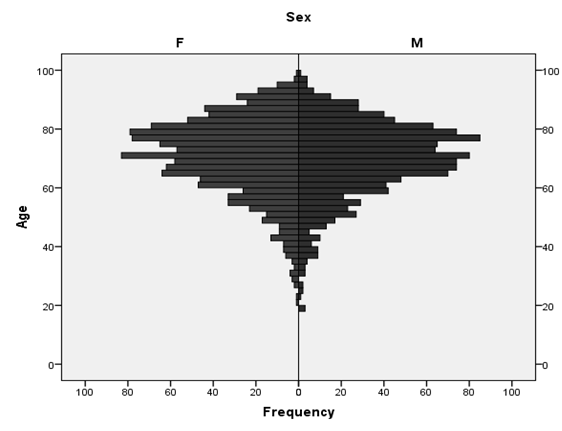
Figure 1 Distribution of 2772 patients treated with antiarrhythmics, by age and gender in Colombia in 2016.
In total, 79.4% of patients used a β-blocker, 58.5% used amiodarone, and 2.9% used calcium channel blockers. In general, the drugs were used at doses lower than DDD, thus establishing a relationship between the average dose administered and the DDD between 0.40 and 1.13 (table 1).
Table 1 Prescription patterns of antiarrhythmic drugs used in 2772 patients in Colombia in 2016.
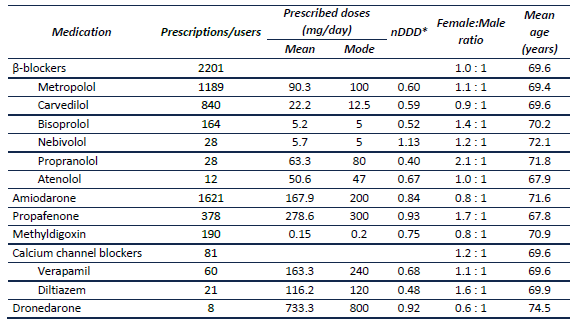
*nDDD: ratio between the prescribed daily dose and the defined daily dose.
Of the total patients, 43.0% were prescribed a single antiarrhythmic, and 57.0% received two or more (figure 2). There were 52.5% of patients administered two medications, 4.4% receiving three and 0.1% patients with four of these medications. Statistically differences were noted between receiving combination therapy according to the sex of the patient (female: 51.7% vs male: 62.6%, p < 0.001). Among the 1580 patients who were prescribed antiarrhythmic combinations, the most frequently used included amiodarone + β-blockers (79.3%), metildigoxin + β-blocker (9.7%) and amiodarone + metildigoxin (7.6%).
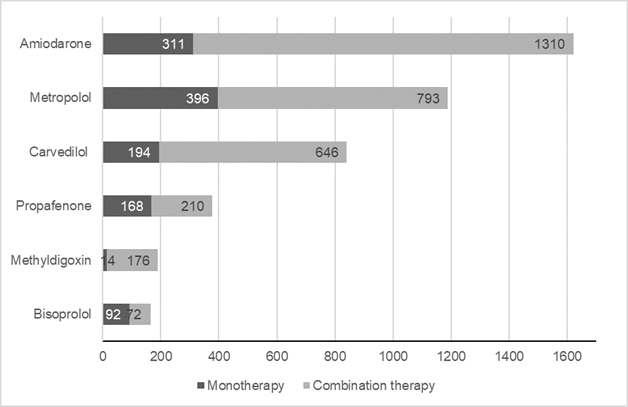
Figure 2 Frequency of prescription of main antiarrhythmics alone or in combination therapy in Colombia in 2016.
Multivariate analysis of the relationship between the use of combination antiarrhythmic therapy and other variables revealed that age older than 85 years and receiving treatment in the city of Bogotá were associated with a lower probability of having a combination of antiarrhythmics. Being male, the presence of diabetes mellitus and the use of some medications (such as the anti-ulcer anti-H2, loop diuretics, statins, aldosterone inhibitors, inhibitors of the renin angiotensin aldosterone system, nitrates and warfarin) increased the probability of having combination therapy ().
Table 2 Variables associated with combined antiarrhythmic therapy in binary logistic regression models in Colombia in 2016.
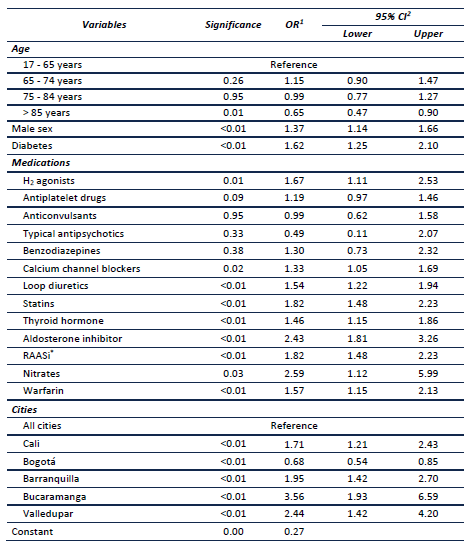
* RAASi: renin angiotensin aldosterone system inhibitors. 1 OR: Odds Ratio. 2 95% Confidence Interval.
A statistically association was noted for a lower combined use of calcium channel blockers and β-blockers (odds ratio [OR]: 0.119; 95% confidence interval [95% CI]: 0.07-0.19). However, 1% receiving both medications were identified, which confers a risk interaction.
Arrhythmias are frequently noted in patients with comorbidities. Among the subjects included, 93.9% received concomitantly one or more of the following groups of medications: lipid-lowering drugs (62.6%, of which 99.1% corresponded to statins); renin angiotensin aldosterone system (RAAS) inhibitors (62.6% of patients); antiplatelet drugs (42.0%, of which 93.6% corresponds to acetylsalicylic acid); antiulcer agents (41.2%); anticoagulants (36.2%); loop diuretics (27.7%); levothyroxine (,22.9%; antithyroid drugs only eight patients); aldosterone inhibitors (17.7%); antidiabetics (17.5%, of which 28.1% had insulin); psychotropic drugs (17.1%); inhaled bronchodilators (11.9%; of which 40.1% are β-2 agonists), thiazide diuretics (10.0%); antihistamines (8.9%); nitrovasodilators (2.0%); and erythropoietin (1.4%).
Age older than 65 years increased the probability of receiving comedication, which was proportional to the increase in age. The use of amiodarone and β-blockers and receiving treatment in the city of Bogotá were also associated with an increased risk of receiving comedications (table 3).
Table 3 Variables associated with antiarrhythmic therapy with comedication in binary logistic regression models in Colombia in 2016.
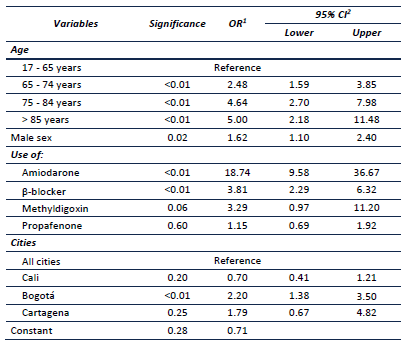
1 OR: Odds Ratio. 2 95% Confidence Interval.
We identified 49.2% patients using medications with conditional risk for QT prolongation, 2.5% 68 with possible risk and 6.2% with known risk.
A statistically significant relationship was identified between the use of amiodarone and the probability of receiving levothyroxine (OR: 1.69; 95% CI: 1.40-2.03) and drugs with conditional risk of QT prolongation (OR: 2.76; 95% CI: 2.36-3.22). Demographic variables and some prescription indicators were compared among the 60 Colombian cities included in this study. Differences were identified in the frequency of combined therapy use and the comedications used among these cities. Table 4 describes the data for the eight main cities.
Discussion
The prescribing patterns of the antiarrhythmic drugs most used in patients affiliated with the SGSSS of Colombia were established. These estimates can be used by administrators and health professionals to design strategies to adjust the prescription of this group of drugs according to clinical practice guidelines. The average age was 70 years, which is similar to some published studies, and cardiovascular diseases prevail in the elderly population13,14. Half of the patients were women, which coincides with other reports (55%)15. The most commonly used medications were β-blockers. Considering that atrial fibrillation is the most common arrhythmia and that clinical practice guidelines recommend the use of β-blockers for their effectiveness in controlling heart rate3,16,17, the widespread use of this group of medicines seems appropriate.
For patients who need control of both heart rhythm and rate, it is recommended to use medications such as β-blockers or digoxin in combination with an antiarrhythmic agent such as amiodarone, which could explain the associations of these drugs identified in our study18. Regarding ventricular arrhythmias, the guidelines recommend β-blockers as first-line drugs because they are effective for primary treatment and the prevention of sudden death due to this type of arrhythmia19.
In the study conducted by Vaughan-Sarrazin et al., where patients with atrial fibrillation were monitored from 2002 to 2011, the prescription of diltiazem, verapamil and digoxin for rate control decreased considerably over time. In contrast, the use of β-blockers increased from 52.3% in 2002 to 61.0% in 2011, especially due to the use of metoprolol and carvedilol. Despite the methodological differences, these findings correlate with the proportion of use of each pharmacological group in our study20.
Specifically, regarding rhythm control, amiodarone was the most widely used medication in the paper of Vaughan-Sarrazin et al.; however, this drug was only prescribed to approximately 10% of patients. In contrast, propafenone and dronedarone were used in less than 1% of patients. These data indicate that amiodarone is still commonly used for rhythm control. In another study in Colombian patients with atrial fibrillation the most frequent approach was heart rate control (72.0% vs 32.8% with rhythm control)21; however, current data support early rhythm control in patients with atrial fibrillation22, but it is recommended to avoid chronic use of amiodarone due to its long-term toxic effects, and to consider other medications such as dronedarone or propafenone (or interventional procedures such as catheter ablation)17.
β-Blockers and calcium channel blockers in general exhibited a relationship between the average dose administered and a defined daily dose close to 0.6. In contrast, amiodarone, dronedarone and propafenone were used at doses close to those defined. In the literature review, no similar studies were identified with which to compare the doses, so these data may be useful for further comparisons in Colombia or for other researchers. Patients with cardiac arrhythmias typically have other comorbidities. One of the most frequent comorbidities is arterial hypertension, which represents a risk factor for the development of atrial fibrillation23. In particular, RAAS inhibitors are some of the most used comedications.
Statins were widely used in the study population, which is consistent with the profile of patients with cardiovascular diseases given that dyslipidemia and atherosclerosis are important risk factors for the development of these morbidities24. Another important disease associated with advanced age and cardiovascular disease is diabetes mellitus25, which is often accompanied by peripheral arterial disease, coronary heart disease and stroke23.
With regard to the problems related to the safety of medicines, treatment with amiodarone can be associated with decreased thyroid function in greater than 20% of patients26. We identified a statistically significant relationship between taking levothyroxine for the treatment of hypothyroidism and being prescribed amiodarone, which may be associated with this risk.
Greater than 50% of total patients were receiving medications with an additional risk of QT prolongation. A high prevalence of risk factors associated with the use of this group of drugs was previously described in the elderly population of Colombia27. Attending physicians should remember that this is an important risk factor for the development of ventricular arrhythmias and therefore of sudden death. Thus, physicians must be aware of this risk interaction and direct a rigorous prescription and follow-up of patients with heart rhythm disorders28.
Amiodarone is classified as a known risk drug for QT prolongation13 and has been identified in multiple cases of Torsades de Pointes, especially when associated with other risk medications29. Thus, the finding of its concomitant use with conditional QT risk drugs is relevant. Additionally, psychotropic drugs that prolong QT can probably be avoided in these combinations, and patients who receive them require an adequate evaluation of the risk-benefit profile and a close follow-up30, especially those with a history of cardiac arrhythmia.
The variations identified in relation to the prescription patterns in the different Colombian cities included in this study, such as the frequency of use of antiarrhythmic drugs, are common given the variability in medical care and the prescription habits noted in pharmacoepidemiological studies.
This research presents certain limitations for the interpretation of some results due to the observational nature of the study, which can be improved with subsequent studies on the use of medications that take into account the information obtained from the clinical records about the diagnoses and indications for which the antiarrhythmics were formulated for, the follow-up, and the appearance of adverse reactions attributable to the medication. The information shown in this study may apply only to populations with similar demographic, insurance and healthcare characteristics.
Conclusions
Based on the above results, it can be concluded that there was a predominance of β-blockers and amiodarone for the treatment of arrhythmias, which may be associated with the recommendations of the clinical practice guidelines for the suggested treatment of the most frequent arrhythmias. Most patients have some degree of comedication, which is related to a high prevalence of comorbidities in elderly people. Future studies should consider examining more variables related to the prescription of these drugs, especially the use of comedications and the presence of comorbidities that may influence the clinical outcome.














